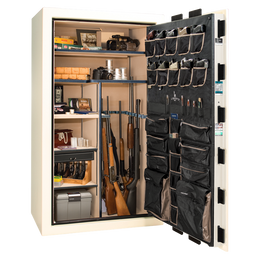With the socioeconomic turmoil and violence of 2020 not so far behind us, many people are more aware of the potential for crime against them, their families, their business, or their property. The good news is that both property crime (burglary, larceny-theft, motor vehicle theft, and arson) and violent crime (things like murder and nonnegligent manslaughter, forcible rape, robbery, and aggravated assault) have been on a general decline in the USA since about 1992.
The bad news is that total crime rates in the USA are still higher than in many other nations. We’re not even close to the top 10 worst (the worst is Venezuela, FYI), but we’re 58th highest out of 195 countries. In addition, in certain areas of the US, crime rates are significantly higher than last year, as we’ll discuss below.
In this article, we’ll review some commonly cited US crime data, discuss some of the problems in reporting crime statistics, and provide some useful tips for avoiding certain types of property and violent crime. First, we need to discuss the problematic nature of US crime statistics as currently reported.
Sources
https://www.statista.com/statistics/191219/reported-violent-crime-rate-in-the-usa-since-1990/
https://www.forbes.com/advisor/legal/criminal-defense/crime-rate-by-state/
https://bjs.ojp.gov/data-collection/ncvs
https://cde.ucr.cjis.gov/LATEST/webapp/#/pages/explorer/crime/crime-trend
https://www.pewresearch.org/short-reads/2024/04/24/what-the-data-says-about-crime-in-the-us/
https://www.statista.com/statistics/1368634/crime-data-reported-fbi-by-state-us/
https://www.cnn.com/2021/10/06/health/us-homicide-rate-increase-nchs-study/index.html
https://www.cdc.gov/nchs/nvss/vsrr/mortality-dashboard.htm#
https://www.vivint.com/resources/article/home-security-systems-deter-crime
Why US crime statistics are inaccurate or incomplete
As with any statistical analysis of human behavior across a complicated nation with over 330 million residents, US crime data needs to be taken with an appropriate grain of salt. The two most often-cited primary sources of violent crime data in the US are the FBI’s published crime statistics and the annual Bureau of Justice Statistics (BJS) report. Both sources paint an incomplete picture of crime in the US for several reasons.
First, the FBI relies on law enforcement agencies to voluntarily report crime data, and not all of this data is reported every year. Pew Research points out that the FBI can only include crimes that have been reported to law enforcement but not crimes that haven’t been reported. Historically, the FBI has also only published statistics about a handful of specific violent and property crimes, but not many other types of crime, such as drug crime. And while the FBI’s data is based on information from thousands of federal, state, county, city, and other police departments, not all law enforcement agencies participate every year. In 2022, the most recent full year with available statistics, the FBI received data from 83% of participating agencies.
Relatively few state agencies voluntarily submit crime data to the FBI
Statista says that due to the FBI's recent transition to a new crime reporting system in which law enforcement agencies voluntarily submit crime reports, data may not accurately reflect the total number of crimes committed. If you look at that report closely you may be shocked to discover how many states’ law enforcement agencies are not accurately reporting crime statistics to the FBI. For example, only 52% of agencies in Illinois and New Jersey voluntarily share their crime statistics with the FBI. California is at 49%, New York only 24%, and Florida at 7.7%.
So, we can confidently say that the FBI’s crime statistics (which are cited by nearly all news outlets and analysts) are inherently flawed or at least woefully incomplete.
BJS survey data is voluntary and incomplete
However, the BJS report is also limited in its scope and accuracy. Rather than relying on law enforcement agencies to voluntarily report their data, the BJS undertakes a large, voluntary annual survey of US residents over the age of 12 and asks them if they’ve been a victim of certain types of crime over the past 6 months. This type of data collection can be said to be superior in some ways since it captures both reported and unreported crimes (unlike the FBI’s data). However, like the FBI report, the BJS survey only covers a few specific types of violent and property crimes. And since it relies on after-the-fact interviews with crime victims, it obviously can’t accurately reflect murder rates. In addition, all surveys asking people about personal and/or traumatic events are inherently inaccurate, and biases can skew the data in fundamental ways.
Social and political biases can influence crime reporting and data analysis
Additionally, political or social biases can influence the way people view and report crime statistics (or anything else). For example, a reporter or news blogger might cite certain specific data if it aligns with the thrust of a report or the political leanings of the parent organization but might ignore other data that contradicts it. ABC News points out another pitfall of relying on voluntary, overall crime statistics. Referring to New York subway crime, they say that while subway crime was down from 2024 to 2023, it actually rose by 46% in January 2024 compared to January 2023, illustrating that overall crime statistics don’t always tell the whole story.
In their story about declining crime rates, NPR reports, There are some outliers to this trend — murder rates are up in Washington, D.C., Memphis and Seattle, for example — and some nonviolent crimes like car theft are up in certain cities. If you’re the BBC and you’re writing a story about the supposedly mistaken surge in violent crime in America, you can cite US media reports or city-by-city analysis: Last December, one US media report said a dozen cities in 2021 had broken records for the numbers of murders, based on data from their local police departments. The New York Times looked at 37 cities across the US with data for the first three months of 2021 and said that overall, there had been an 18% increase in murders compared with the same time period in 2020. BBC also reported Chicago has had one of the worst records for murders in the US and saw a big increase from 2019 to 2020 (up nearly 55%) but a much smaller rise in 2021 (up just 3%).
A smaller rise in murders is still a rise, and Chicago has among the highest murder rates of any large American city. But if you want to highlight a trend toward lower crime rates, you can point to a smaller rise in murders than in previous years.
Recognizing the limitations of its current crime statistics reporting system, the FBI is in the process of transitioning to the NIBRS (National Incident-Based Reporting System), which will include data for a much wider range of crimes. However, it’s not quite ready for prime time yet. All this being said, when you look at the general trends shown in both the FBI’s and BJS’s data, you can glean enough information for some interesting analysis, as long as you remain aware that the specifics of the data shouldn’t always be taken at face value. So, let’s continue and see what we can learn.
What types of crime are most common in the USA?
In the USA, property crime is by far the most common type of crime. The most recent FBI report shows a total of 1,954.4 property crimes per 100,000 people, compared with 380.7 violent crimes per 100,000 people.
What is property crime, and what are the average rates in the US?
For the purposes of the FBI’s data as reported in the Uniform Crime Reporting (UCR) Program, property crime includes the offenses of burglary, larceny-theft, motor vehicle theft, and arson. The FBI’s published national average rates of property crime per 100,000 people are:
- Larceny/theft: 1,401.9
- Motor vehicle theft: 282.7
- Burglary: 269.8
- Arson: 19.6
What is violent crime, and what are the average rates in the US?
Under the FBI’s UCR Program, violent crime is composed of four offenses: murder/nonnegligent manslaughter, rape, robbery, and aggravated assault. Violent crimes are defined in the UCR Program as those offenses that involve force or threat of force. The FBI’s published national average rates of violent crime per 100,000 people are:
- Aggravated assault: 268.2
- Robbery: 66.1
- Rape: 40.0
- Murder/nonnegligent manslaughter: 6.3
Note: The FBI’s Uniform Crime Reporting Program defines murder and nonnegligent manslaughter as the willful (nonnegligent) killing of one human being by another. The classification of this offense is based solely on police investigation as opposed to the determination of a court, medical examiner, coroner, jury, or other judicial body. The UCR Program does not include the following situations in this offense classification: deaths caused by negligence, suicide, or accident; justifiable homicides; and attempts to murder or assaults to murder, which are scored as aggravated assaults.
What’s the difference between theft, burglary, and robbery?
The government Office for Victims of Crime (OVC) report points out that burglary, theft, and robbery each amount to billions of dollars in total monetary losses every year. So, what do these terms mean?
Larceny or theft
Larceny-theft (most often termed simply theft) is defined as the unlawful removal of property. If a theft is committed that doesn’t conform to the additional conditions below, then it is categorized as larceny, larceny-theft, or theft, depending on the organization categorizing and recording the crime.
Larceny-theft of motor vehicles is the most common type of theft, at 24%, with shoplifting a close second at 22%. Other types (35% combined) include pocket-picking, purse-snatching, coin-operated machine thefts, thefts involving items from behind a fenced enclosure, the theft of animals, outdoor furniture and machinery, boats, jet skis, and airplanes.
Burglary
Burglary is defined as the unlawful entry into almost any structure with the intent to commit a crime inside. So, even if a bad guy unlawfully enters a structure with the intent to commit a crime but doesn’t actually steal anything, he can be charged with burglary.
Robbery
Robbery, as opposed to burglary or theft, which are property crimes as discussed above, specifically involves the violent theft of property or money. Robbery involves the victim personally, and the perpetrator uses either force or the threat of force to coerce the victim into relinquishing property or money. Robbery is thus categorized as a violent crime. At the time of the OVC report, 42% of robberies involved the use of strongarm tactics, 41% involved the use of firearms, and 8% involved the use of a knife or other cutting instrument. The FBI defines strong-arm tactics as the use of hands, arms, feet, fists, or teeth as a weapon.
Are crime rates rising or falling in the USA?
As we stated above, the general trend since the early 1990s is that national crime rates have been dropping, which is a good thing. However, it’s not a continuous, steady decline. There are ups and downs. There was a general upward trend (rise in national crime rate) between 2014-2016 and another between 2019 and 2020. For example, during the pandemic and social unrest of 2020, the murder rate jumped by 30% over the previous year, which was the largest year-over-year increase in over a century.
Additionally, as discussed above, a city-by-city analysis citing police department reports may show very different trends than the national average. Chicago, Washington DC, Memphis, and Seattle are among cities with growing crime rates compared to previous years. (See below for a list of cities with record-high murder rates recently.)
The Council on Criminal Justice (CCJ) year-end report points out that although national crime statistics have been trending lower, certain areas and certain types of crime have been increasing disturbingly in the 38 cities included in the CCJ report. Specifically, Motor vehicle theft, a crime that has been on the rise since the summer of 2020, continued its upward trajectory through 2023. There were 29% more reported motor vehicle thefts in 2023 than in 2022.
Additionally, Most violent offenses remained elevated in 2023 compared to 2019, the year prior to the outbreak of COVID and the widespread social unrest of 2020. There were 18% more homicides in the study cities in 2023 than in 2019, and carjacking has spiked by 93% during that period.
BJS tracks a slightly different set of offenses from the FBI and CCJ, but it finds the same overall patterns, with theft the most common form of property crime and assault the most common form of violent crime. The national trend of both property and violent crime is downward in both the FBI and BJS reports. However, if you’re living in one of the locations where certain types of crime are exploding in frequency, hearing that there’s a general downward trend in national crime rates is not likely to make you feel any better.
States with the highest crime rates (most dangerous places to live)
As we have pointed out above, figuring out the overall worst crime rates by state can be difficult. Not only do you have to take into account the inherent inaccuracy of available crime data from various sources, but violent crime and property crime are usually separated. So, while one state may have a fairly low violent crime rate, it might have a very high property crime rate (for example, see Colorado in the table below).
If you want to know the overall worst states for crime rate, taking into account both violent and non-violent crime, you need to decide what statistics to prioritize and how to weigh each category. In an attempt to come up with a usable list of states with the overall worst crime rates calculated in this fashion, Forbes determined the states with the overall worst crime rates per 100,000 people. Utilizing available violent crime statistics balanced against property crime data and combining those figures with the overall chance of being a victim of violent crime in each state, Forbes came up with the 10 worst states for crime rates:
- New Mexico (7.8 violent, 29.84 property)
- Arkansas (6.45 violent, 24.52 property)
- Louisiana (6.29 violent, 27.48 property)
- Colorado (4.92 violent, 31.48 property)
- California (4.99 violent, 23.43 property)
- Tennessee 6.22 violent, 23.02 property)
- Missouri (4.88 violent, 23.40 property
- South Carolina (4.91 violent, 23.08 property)
- Nevada (4.54 violent, 23.80 property)
- Alaska (7.59 violent, 17.89 property)
States with the lowest crime rates (safest places to live)
Here are the 10 states with the lowest combined overall crime rates using Forbes’ methodology (see Forbes article for more details):
- Virginia (2.34 violent, 16.96 property)
- Vermont (2.22 violent, 16.71 property)
- West Virginia 2.78 violent, 12.30 property)
- Wyoming (2.02 violent, 16.37 property)
- Kentucky (2.41 violent, 9.27 property)
- Idaho (2.41 violent, 9.27 property)
- New Jersey (2.03 violent, 14.17 property)
- Connecticut (1.50 violent, 14.94 property)
- Rhode Island (1.72 violent, 12.85 property)
- Maine (1.03 violent, 12.13 property)
- New Hampshire (1.26 violent, 10.11 property)
States with the highest and lowest murder rates
According to the CDC’s National Vital Statistics System, over the past 2 years, the homicide (murder) rates are highest in the following states (2023 age-adjusted homicide rates per 100,000 people):
- Mississippi (20.2)
- Louisiana (18.9)
- Alabama (15.0)
- New Mexico (14.3)
- Arkansas (11.6)
- South Carolina (11.6)
- Tennessee (11.5)
- Missouri (11.3)
- Maryland (10.8)
- Georgia (10.5)
The states with the lowest homicide rates (using the same parameters) are:
- New Hampshire (1.8)
- Maine (1.9)
- Rhode Island (2.2)
- Utah (2.3)
- Massachusetts (2.7)
- Hawaii (2.8)
- Idaho (2.8)
- Nebraska (3.1)
- Iowa (3.2)
- New Jersey (3.2)
Comparing the CDC’s numbers with the Forbes/FBI numbers for violent crime in the sections above demonstrates why you need to be careful taking any particular source’s data at face value. Each has its own methodology for gathering, vetting, and categorizing data, and they are often at odds with each other. It’s best to consult multiple sources, do your own primary research where possible, and balance all the available information before forming any conclusions. Read more details about the CDC’s sources and methodology.
Cities with record-high homicide rates lately
ABC News reports that at least 12 US cities have broken their annual homicide records over the past couple of years, including:
- Philadelphia, PA
- Rochester, NY
- Toledo, OH
- Columbus, OH
- Baton Rouge, LA
- Louisville, KY
- Indianapolis, IN
- St. Paul, MN
- Albuquerque, NM
- Portland, OR
- Tucson, AZ
- Austin, TX
Tips for reducing your chances of being a crime victim
In some cases, random crimes simply occur, and there’s not much you can do about it. However, in many cases, crimes can be prevented by careful planning and preparation on your part. Let’s go over some proven ways of reducing your chances of being a victim of a crime.
Install good locks, exterior lights, cameras, and an alarm system
If you live in a house, installing good deadbolt locks, solid-core doors with reinforced kick-plates, window guards/locks, motion-activated exterior lights, and a camera-equipped alarm system can go a long way toward preventing burglary and theft. Smart home systems have become very affordable and convenient to install and can make a big difference in keeping your home monitored and secure. One study found that 83% of burglars took the time to look for a home security system. Another 60% said that if there was a burglar alarm in the home, they would choose another target.
A motion-activated exterior lighting system can drive away bad actors who don’t want people to see what they’re up to in the dark. And be sure to put up a sign in your yard and/or window stickers showing that you are running a security system.
Having your home broken into by a burglar is much more likely than your business being burgled. 72% of burglaries occur in residential dwellings, while only 28% occur in non-residential buildings (offices, businesses, stores, and other non-residential buildings).
While the stereotypical burglar is often depicted as a night prowler sneaking into your home under the cover of darkness, your home is actually more at risk of burglary during the day (about twice as likely). Be aware and take the necessary precautions.
Keep your garage door closed and locked down
Many burglaries and thefts are crimes of opportunity, and if you forget to close your garage door, it’s a (literal) open invitation to thieves. Even if all the thief does is saunter into your garage and walk away with some tools, it can be hundreds or even thousands of dollars in losses. If you use electronic garage door openers, make sure to read and follow the directions carefully, and if you’re going to be away from your home for more than a day, lock your garage door physically.
Start a neighborhood watch program
Do you know that nosy neighbor lady who always seems to know your business? She’s what you want. Ask around and see if there’s a local neighborhood watch program already in place, and sign up. If not, start one and ask your neighbors to join. People who pay attention and let their neighbors know when something is out of the ordinary can make a big difference in reducing crime, particularly when working in concert with local law enforcement. It works for people in condos and apartments, too!
Get a dog
It may be a little cliché, but studies show people with dogs may experience lower rates of both violent and property crime. Burglars don’t want to attract attention, and a good noisy dog can alert neighbors or passersby that something isn’t right. Additionally, a well-trained dog can help defend you from personal attacks. Plus, dogs are cool. Just make sure you take care of it and it will take care of you.
Let your neighbors know when you’re going out of town
If your neighbor sees someone carrying boxes out of your house, they will likely not think anything of it… unless you’ve let them know that you’re out of town for a few days. Let your (trustworthy) neighbors know your plans so they can help guard against burglary. Then you can return the favor to them!
Avoid sketchy areas and situations
Follow your instincts, and be honest with yourself. If you don’t feel good about going to a certain area or engaging in a particular activity, don’t. Don’t worry about offending your friends or missing out. If you feel unsafe in an area, avoid it.
Cover your PIN and use strong passwords when using cards/keypad pay methods online or in person
Believe it or not, people still are victims of theft and scams because they don’t protect their PIN well enough when using debit or credit cards at point-of-purchase keypads. Educate yourself about RFID skimmers as well… thieves are getting pretty sophisticated. Always use strong passwords when shopping online, and review your credit reports and statements regularly to check for any strange activity.
Schedule package deliveries or sign up for a locker
Package theft has reached epidemic proportions. Try to pick up delivered packages as soon as possible. Better yet, ask for signature confirmation and schedule deliveries only during times when you’ll be at home. You can also often get packages delivered to handy lockers at many larger retailers at no cost, and you can pick them up there at your convenience.
Stay alert, pay attention, and scan your surroundings
These days it’s very common for people to have their heads down, earbuds in, and eyes glued to a smartphone screen. These are the kinds of people who are easy for criminals to victimize. If you keep your head up, walk confidently, and scan your surroundings regularly, you’ll make less of a target for bad actors.
Don’t open your door to service people (or anyone you don’t know)
If a service person requests entry to your dwelling, call the company and confirm before letting them in. If someone wants to use your phone, don’t let them in. Offer to make the call for them. If they are legitimate, they’ll understand your reluctance and agree.
Get CCW and/or self-defense training, and carry pepper spray
Being armed with a Concealed Carry Weapon (and trained sufficiently) has been shown to deter violent crime in many cases. Often, the knowledge that a potential victim is armed causes a perpetrator to change their mind and find a different target. However, make sure you know your local laws and keep up your skills through regular range practice.
Even if you don’t feel good about carrying a gun, it’s a good idea to get hands-on personal defense training from a qualified instructor, and consider carrying chemical self-defense spray and learn how to use it properly.
Don’t be alone
Females in particular are more vulnerable to violent crime if walking, jogging, hiking, or driving alone, but men traveling alone are also more likely to be targeted. Try to engage in these activities with a friend or two when possible, and if you have to be alone, consider taking a dog along (see above) and definitely get some self-defense training. Stay on well-lit trails and sidewalks, ideally with people around.
Plan for an escape
Whether on foot or in a vehicle, always plan a way to get moving if you’re suddenly approached by a threat. Don’t stop at traffic lights with your bumper right up against the car in front of you… leave some space so you can get out of line and escape if a carjacker or other threat approaches you. If you’re on a bike or on foot, look around and consider where you might escape in the case of a surprise threat.
Prepare yourself mentally
It’s not fun, but preparing yourself for a potential attack and planning what you will do can go a long way toward lessening or preventing the effects of violent crime. Some people freeze up and go into shock, and many criminals count on this. Don’t be a defenseless sheep. Plan mentally (and physically), and you’ll be better off.
Move
It may sound extreme or even obvious, but if your neighborhood has become a haven for violent crime and theft and your local politicians and law enforcement agencies are not willing to do enough about it, it may be time for you to relocate to a better part of the state or even a better part of the country.
Buy a good home safe or gun safe
A quality home or gun safe is designed and intended to deter opportunistic burglars and delay professional burglars. The longer it takes a bad guy to break into your safe, the greater chance someone will notice and the police can be notified. If a safe is too difficult to break into, a burglar may give up and leave. No safe is absolutely impenetrable, but a good safe will go a long way toward protecting your valuables from fire, unauthorized access, humidity damage, and theft.
*Made in the U.S.A. from U.S. and Global Parts.










